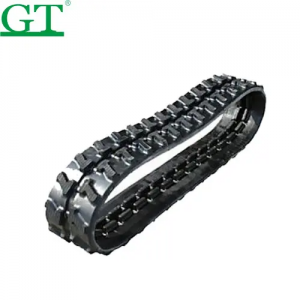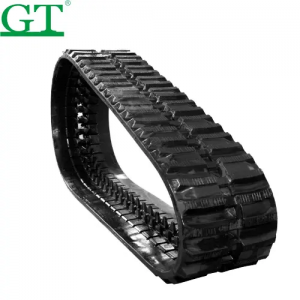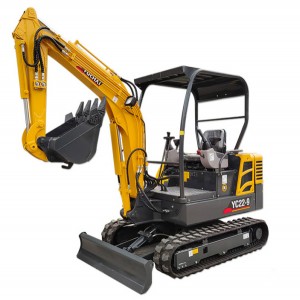How to Measure the Rubber Track of Mini Excavator
A Look Inside a Mini Excavator’s Rubber Tracks

Pictured above is a set of damaged tracks to give you an idea of what the tracks look like on the inside.
Mini excavator’s rubber tracks are embedded with one of the following:
- Continuous steel cords
- Non-continuous steel cords
- Continuous steel belt
- Continuous nylon belt
Most mini excavators use steel core rubber tracks. Steel core rubber tracks utilize a rubber outer core with embedded steel plates and cables. The steel plates protrude from the inner center of the rubber track to make up the drive lugs.
Steel core rubber tracks either have continuous steel cords or non-continuous steel cords embedded inside of the rubber.
#1 Continuous steel cords
The continuous steel cords form an ongoing loop which is not spliced or connected at the end with a single joint. Rubber tracks utilizing this type of steel cord technology are stronger because these cords are less prone to snapping when they are twisted and stretched.
#2 Non-continuous steel cords
The non-continuous steel cords inside of the mini excavator’s steel core rubber tracks have a single joint that connects the cords at the end. Over time, the joint is stretched and can become weak causing the non-continuous cord to be more prone to snapping.
#3 Continuous nylon belts
Multi-Terrain Loaders from ASV, Terex, and some older Cat mini excavators, use tracks that are not embedded with steel referred to as non-metal core tracks. These types of tracks use continuous nylon belts which can tear easily.
#4 Continuous steel belt
Another type of rubber track option on the market utilizes a continuous steel belt. This type of rubber track is the strongest option because unlike, the continuous steel cords that have gaps in between the cords, the continuous steel belt is just one sheet of steel.
Whether you are using a mini excavator with rubber tracks that are embedded with continuous steel or non-continuous steel cords, belts, or nylon, the way you measure the rubber track size stays the same.
Measuring the Rubber Track Size
When you don’t see the rubber track size stamped onto the underside of your mini excavator’s tracks, then you can use simple steps to measure the track size.
Before we go into using those steps, I want to first briefly go over a few key terms to help you understand exactly what you are measuring.
Rubber tracks manufacture created an industry-standard or a formula that is used when measuring the size of your mini excavator’s rubber tracks.
The formula is Width X Pitch X Links.
Ok, so we have the formula, but what are these measurements that make up this formula and how do we measure them?
Rubber Track Size Measurements
Rubber Track Width

How wide your rubber track is from one side to the other.
To measure the width of your track, place your tape measure across the top of the rubber track and note the size. The width size will always be shown in millimeters (mm).
Rubber Track Pitch

The measurement from the center of one lug to the center of the next lug.
Place your tape measure on the center of one of your drive lugs and measure the distance from the center of that drive lug to the center of the drive lug next to it.
This measurement is taken from the inside of the track. This measurement will also always be shown in millimeters (mm).
Rubber Track Links

The total number of drive lugs on the inside of your rubber track.
The total number of drive lugs or links can be measured by marking one link and then counting each link around the total circumference of the track until you come back around to the link that was marked.
Once you have these three measurements, you will know your mini excavator’s rubber track size, which may look something like this 180x72x37. This track size shown combines your rubber track’s width of 180mm, with a pitch of 72mm, with 37 drive lugs or links.
Four Signs of Wear and Tear on Rubber Tracks
It is very important to replace your mini excavator’s rubber tracks at the first sign of potentially unsafe wear. Doing so can reduce the amount of downtime and maximize your productivity.
If you aren’t sure if your mini excavator rubber tracks need replacement, you can always look for the following four signs of wear and tear:
#1. Tread Depth
A brand-new rubber track typically has a tread depth of 1 inch deep. If your tracks are about halfway worn out, you will be lucky to get a tread depth of 3/8 of an inch each deep.
You may also notice that raised portions of the tread are flattening or are no longer visible.
#2. Cracks
The exterior of your rubber tracks is susceptible to cracks because of the usage on rough and rocky terrains.
If you notice multiple exterior cracks on your rubber track, it is a good idea to replace the rubber track.
#3. Track Tension
Rubber tracks stretch over time and you may notice the lack of tension on your rubber tracks or you may notice the rubber track is jumping off the undercarriage.
It is recommended that you check the tension every five days.
To check the tension, lift the track frame off the ground and you may see sag between the track roller and the top of the track lug.
It is not recommended to rectify the issue by tightening the tracks beyond the instructions of the manufacturer. Replacing your rubber tracks is a more efficient decision
#4. Lugs
When working with debris, it is very easy for lugs to become damaged and come out because sprockets continuously slip against them. If you notice that lugs are missing, that is a good indicator that you should replace your rubber tracks.
Benefits of Rubber Tracks

Rubber tracks are a smart choice for contractors who are working on job sites with a terrain that requires a lot of traction, such as mud, dirt, and slopes.
Using rubber tracks increases the flotation of the mini excavator as a result of reduced ground pressure and a more even distribution of machine weight, allowing the mini excavator to effortlessly float over the soft terrain.
Machines running rubber tracks work very well on hard abrasive surfaces like concrete because unlike steel tracks, rubber tracks will not tear up those surfaces.
Rubber tracks suppress the vibration to minimize the stress on undercarriage parts, slowing wear and preventing damage.
Mini excavators take on a wide variety of small to mid-sized projects and equipping them with high-quality rubber tracks can easily improve productivity and increase the longevity of your mini excavator.
However, you will need to replace your mini excavator tracks at some point.
Here are some simple steps that will help you measure the correct track size for when you need to replace your mini excavator tracks.













